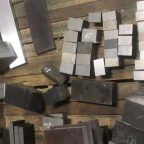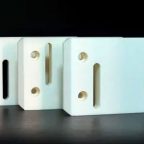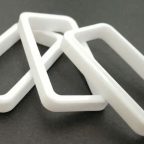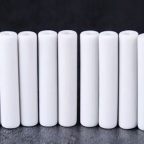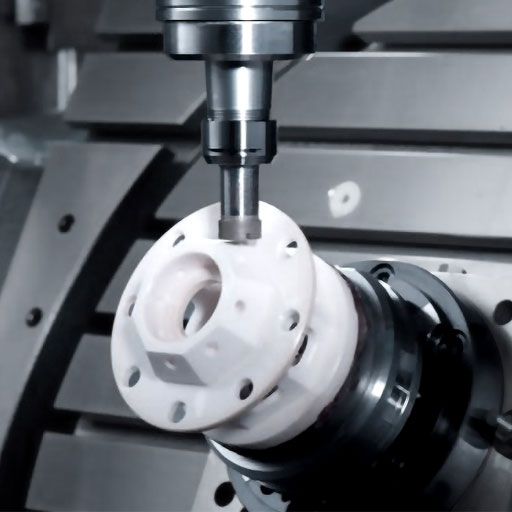Injection Process
The injection process includes three stages of injection, pressure holding and cooling and setting, that is, the powder is heated and softened first, then injected into the mold, held in the mold for a period of time, and finally cooled to prepare a blank with the desired shape. Every stage of the injection process is critical, and improper control can lead to cracks, delamination, separation of powders and organic binders, and many other defects in ceramic parts. Wang Hekun et al. [22] found through a large number of experiments that compared with the injection speed and the holding pressure, the injection temperature and injection pressure are the keys to determine the quality of the ceramic body, and to determine the optimal injection temperature and pressure of the binder system used (120). -140 °C, 50 MPa). Degreasing process Degreasing process is the process of expelling the organic matter in the ceramic body by physical or chemical methods [23], which is the most critical step in the injection molding process. If the degreasing process is not properly controlled, it will lead to a series of defects such as deformation, cracking, bubbling and stress concentration of the green body [24-25]. In addition to the traditional thermal degreasing, solvent degreasing and siphon degreasing, the current degreasing process has also developed new degreasing methods such as catalytic degreasing, water-based extraction degreasing and supercritical degreasing [26].Thermal Degreasing
Thermal degreasing is the process of melting, volatilizing and cracking the organic binder in the ceramic body by heating, and is only suitable for ceramic parts with small cross-sectional dimensions. The heating time, holding temperature and holding time in the thermal degreasing process are very important parameters. Too fast debinding rate will cause defects such as cracks in the green body, and too slow debinding rate will consume time and energy. How to determine the best degreasing heating program is the key to thermal degreasing, and the commonly used method is to conduct thermal weight loss test on organic binders. The study found that the degreasing process of Al2O3 ceramic body can be divided into low temperature stage and medium high temperature stage, the former is the key to degreasing, and a lower heating rate should be selected in this stage.Solvent Degreasing
Solvent degreasing (also known as dissolution extraction degreasing) is to diffuse in the green body through low-molecular-weight solvents (such as acetone, heptane, hexane, etc.), contact and dissolve the binder, form a binder-solvent solution, and finally diffuse to the surface of the green body [29]. Compared with thermal degreasing, solvent degreasing has high efficiency and greatly reduces the time required, but requires higher equipment, complicated process, and most solvents are harmful to human body and the environment. Yan Xingwei et al. [30] compared two degreasing solvents, gasoline and n-heptane, and found that the degreasing effect was better and the speed was faster when gasoline was used as the solvent.Siphon Degreasing
Syphon degreasing involves placing a shaped body on a porous substrate and heating the body to a point where the viscosity of the binder is low enough to allow capillary flow. At this time, the binder is sucked out into the suction material under the action of capillary force, and the siphon degreasing speed is fast, but the organic carrier powder will adhere to the ceramic body and be difficult to remove.Catalytic Degreasing
Catalytic degreasing is a new type of rapid degreasing process. The binder in the ceramic body is rapidly degraded into small volatile molecules in a special atmosphere (catalyst atmosphere), and then diffused out of the body under the action of high vapor pressure. The advantages of catalytic degreasing are that the speed is fast, the linear speed can reach 1-2 mm/h, the debinding temperature is low, and the green body is not deformed during the debinding process. However, high concentration of nitric acid is needed as a catalyst, which requires high equipment. At present, only polyacetal resins are found to be suitable for catalytic degreasing, so their use is greatly limited.Found that the speed of catalytic degreasing was the fastest in the early stage (the first 2-3 h), and as the reaction progressed, the catalytic speed gradually slowed down until the end.Water-based Extraction And Degreasing
Water-based extraction degreasing is improved on the basis of solvent degreasing and is widely used in ceramic powder injection molding. The binders used are divided into two categories: one is water-soluble, such as polyethylene glycol (PEG), polyethylene oxide (PEO), etc., which can be directly removed by filtration of water; the other is insoluble in water. Parts, such as polyvinyl butyral resin, are generally removed by heating. Water-based extraction degreasing has the characteristics of fast degreasing rate, little damage to green body, and friendly to human body and environment. It is an important research direction in degreasing system. Yang Xianfeng [32] systematically studied the water-based extraction and degreasing of tetragonal zirconia (Y-TZP) ceramics and the properties of injection molding green bodies. The binder mainly uses PEG, PVB (or PMMA) and some auxiliary binders. It was found that in deionized water at 40 ℃, the ceramic test strip of PEG/PVB system can remove about 67% of PEG in 2 h, and the ceramic test strip of PEG/PMMA system can also remove 65% of PEG in 4 h.Supercritical Degreasing
Supercritical extraction and degreasing is the most advanced physical degreasing technology at present. It uses supercritical fluid to dissolve and separate the binder in the ceramic body. It has the advantages of non-toxic and harmless, high efficiency and low cost. When the gas (generally CO2) is in a supercritical state, it has the property of dissolving non-polar molecules and low-molecular-weight organic substances (insoluble polar molecules and high-molecular-weight organic substances), and the low-molecular-weight organic substances in the green body can be extracted first. Come out, and then quickly heat to remove other parts, and finally achieve the purpose of degreasing. Wu Yin et al. [33] found that compared with thermal degreasing, supercritical degreasing green body does not produce defects such as cracking, deformation, collapse, and the degreasing rate is much faster than thermal degreasing, which is more than 10 times that of the latter.Pintejin machining ceramic service include : Alumina Ceramic Parts, Zirconia Ceramic, Silicon Carbide Ceramic, CNC Machined Aluminum Nitride Ceramic, Machinable Ceramic Parts, Glass Ceramic,Macor Ceramic,Powder Metallurgy Dies,Ceramic Injection Molding,Ceramic Dry Pressing,Ceramic Extrusion Dies
In the field of precision machining, particularly for CNC (Computer Numerical Control) machining of non-circular Read more
Wear-resistant zirconia ceramic cutters manufacturers claim that zirconia ceramic cutters are ceramic inserts for high-tech Read more
Sheet forming also belongs to plastic forming. The prepared billet is mixed with a certain Read more
For ceramic knives, how much do you know about ceramic knives in addition to their Read more
With the advancement of modern technology, ceramic nozzles are more and more widely used, and Read more
Classification of advanced functional ceramics: (l) Piezoelectric ceramics Piezoelectric ceramics refers to a functional ceramics Read more
The properties of zirconia ceramic powder are very important to the quality of the advanced Read more
Zirconia ceramic materials can be processed to produce industrial ceramic parts, such as zirconia ceramic Read more
